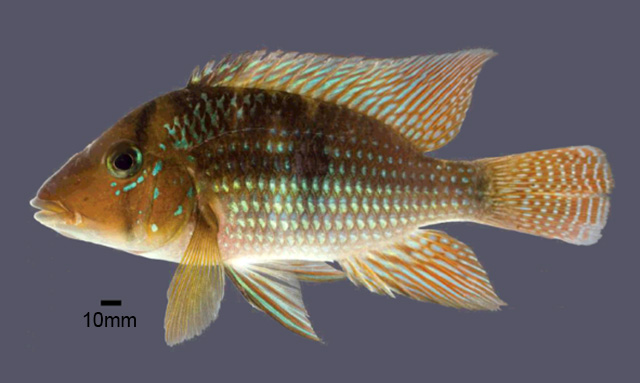| Cichlidae (Cichlids), subfamily: Geophaginae |
| 15.34 cm SL (male/unsexed) |
|
benthopelagic; freshwater |
| South Amercia: Brazil. |
|
This species is distinguished from all other species of G. brasiliensis group by having by having dorsal and anal fins with blue stripes parallel to fin rays on their longest portion (vs. transverse blue bands crossing rays or fins with dots) and the basal portion of caudal-fin with short, longitudinal bluish-white lines (vs. dots or bars); further distinguished except for G. rufomarginatus, G. obscurus, by the presence of an oblique iridescent blue zone between the humeral region and the anterior portion of the dorsal-fin base (vs. no iridescent blue zone); differs from G. obscurus by having having an oblique suborbital row of aligned, small iridescent blue marks, not extending to cheek (vs. suborbital iridescent blue marks irregularly arranged extending to the cheek) and with chest profile straight in lateral view (vs. convex); differs from G. rufomarginatus by having dorsal-fin lappets with grey or dark brown edges (vs. red), with denticles on gill-rakers of the first branchial arch (vs. absent); differs from G. itapicuruensis by having D XIV (vs. D XIII) and lateral spot rounded (vs. elliptical); differs from G. diamantinensis by the absence of a dark brown mark on the humeral region (vs. presence), no horizontal dark brown band on the snout (vs. present), and urohyal bone with strong constriction (vs. with gentle anterior constriction); differs from G. brasiliensis by having a terminal mouth (vs. sub-dorsal) (Ref. 119412). |
|
|
Not Evaluated (N.E.) Ref. (130435)
|
| harmless |
|
Source and more info: www.fishbase.org. For personal, classroom, and other internal use only. Not for publication.

